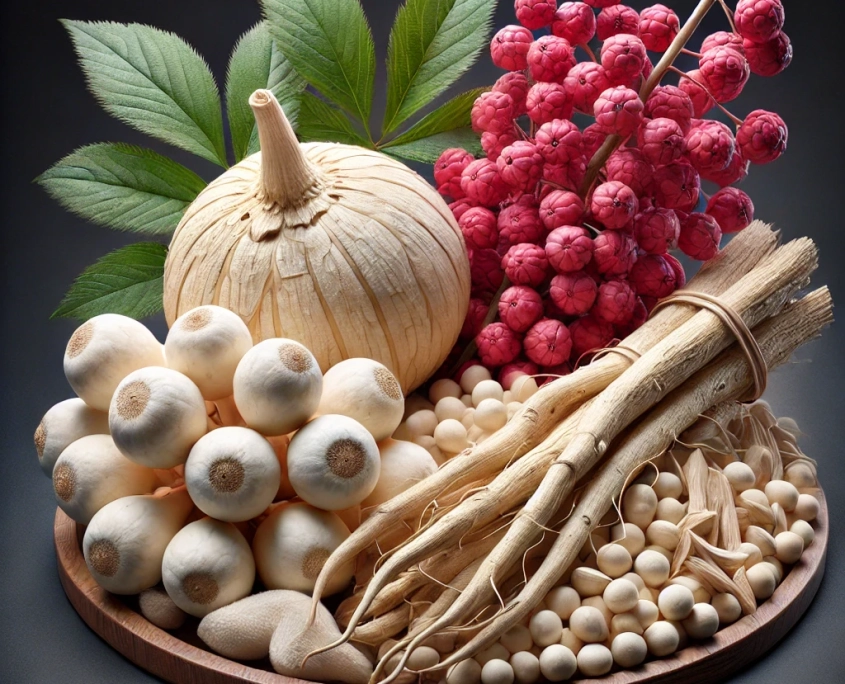Herbal Support for Healthy Menstrual Cycling: An In-depth Analysis of FemCo’s Core Ingredients

Abstract
This paper explores the therapeutic potential of FemCo, a herbal supplement formulated with White Peony root, Shatavari root, and Schisandra fruit. These botanicals have been used traditionally in various medicinal systems for their benefits in supporting female reproductive health, particularly in normalizing menstrual cycles, alleviating cramping, and promoting overall well-being. This paper examines the historical uses, clinical applications, active ingredients, and mechanisms of action of these herbs, providing a comprehensive understanding of their combined effects within FemCo.
Introduction
FemCo is designed to support normal reproductive function, encourage healthy menstrual cycling, and ease mild cramping associated with menstruation. This paper aims to elucidate the biochemistry and therapeutic benefits of its three main herbal constituents: White Peony root (Paeonia lactiflora), Shatavari root (Asparagus racemosus), and Schisandra fruit (Schisandra chinensis). By examining the historical context, clinical uses, and active compounds, this paper provides insights into what can be expected from the combination of these ingredients.
Historical Uses
White Peony Root: In traditional Chinese medicine (TCM), White Peony root has been utilized for centuries to regulate menstruation, alleviate menstrual pain, and balance the liver’s function. It is known for its cooling properties, making it effective in treating conditions characterized by heat, such as excessive menstrual bleeding.
Shatavari Root: Shatavari is a revered herb in Ayurvedic medicine, often referred to as the “queen of herbs” due to its role in supporting female reproductive health. It has been traditionally used to enhance fertility, stabilize hormonal imbalances, and as a general tonic for women, particularly those of childbearing age.
Schisandra Fruit: Schisandra fruit has a long history of use in TCM, where it is classified as an adaptogen. It is recognized for its ability to protect against stress and to enhance liver function, making it beneficial for maintaining hormonal balance.
Clinical Uses and Active Ingredients
White Peony Root
- Active Ingredients: The primary active compound in White Peony root is paeoniflorin, a monoterpene glycoside known for its anti-inflammatory, analgesic, and antioxidant properties. Paeoniflorin has been shown to exert a calming effect on the nervous system and to help regulate immune responses.
- Clinical Uses: White Peony is often used in formulations aimed at alleviating menstrual disorders, such as dysmenorrhea and irregular menstruation. It has also been studied for its role in reducing menstrual cramps and supporting overall reproductive health.
Shatavari Root
- Active Ingredients: Shatavari contains steroidal saponins known as shatavarins, which are believed to be responsible for its estrogenic effects. These compounds help to balance hormonal levels and support the female reproductive system.
- Clinical Uses: Shatavari is widely used to support fertility, manage symptoms of menopause, and alleviate PMS. It is also known to enhance the production of breast milk in lactating women.
Schisandra Fruit
- Active Ingredients: The key bioactive compounds in Schisandra are lignans, which have been shown to possess hepatoprotective, anti-inflammatory, and antioxidant effects. These lignans, particularly schizandrin and gomisin A, play a significant role in modulating the liver’s detoxification pathways.
- Clinical Uses: Schisandra is utilized to enhance liver function, reduce fatigue, and improve physical endurance. It is also recognized for its role in balancing cortisol levels, making it a valuable adaptogen in managing stress.
Mechanisms of Action
White Peony Root: Paeoniflorin’s ability to modulate inflammatory pathways is central to its therapeutic effects. It inhibits the production of pro-inflammatory cytokines, reducing pain and inflammation associated with menstrual disorders. Additionally, paeoniflorin promotes the relaxation of smooth muscles, helping to alleviate menstrual cramps.
Shatavari Root: Shatavari’s saponins are thought to mimic the effects of estrogen, which helps regulate the menstrual cycle and mitigate symptoms of hormonal imbalances. By supporting estrogen metabolism, Shatavari may also help in reducing the severity of menopausal symptoms.
Schisandra Fruit: The lignans in Schisandra enhance the liver’s detoxification processes, which is crucial in the metabolism of hormones like estrogen. By promoting efficient detoxification, Schisandra helps to maintain hormonal balance and reduce the burden on the liver, especially in the presence of environmental stressors.
Synergistic Effects of the Ingredients
The combination of White Peony, Shatavari, and Schisandra in FemCo offers a multifaceted approach to supporting women’s health. White Peony and Shatavari work together to regulate hormonal balance and menstrual cycles, while Schisandra enhances liver function, ensuring efficient metabolism and excretion of hormones. This synergistic blend helps to alleviate common menstrual symptoms, reduce stress, and promote overall well-being.
FemCo leverages the historical and clinical knowledge of White Peony, Shatavari, and Schisandra to offer a natural solution for supporting reproductive health in women. The active ingredients in these herbs work through complementary mechanisms to ease menstrual discomfort, balance hormones, and support liver health, making FemCo a valuable addition to women’s health regimens.
References
- Bone, K., & Mills, S. Principles and Practice of Phytotherapy: Modern Herbal Medicine. 2nd ed. Churchill Livingstone, 2013.
- Guyton, A.C., Hall, J.E. Textbook of Medical Physiology, 10th Edn. W.B. Saunders, Philadelphia, 2000.
- Frawley, D., & Lad, V. The Yoga of Herbs: An Ayurvedic Guide to Herbal Medicine, 2nd Edn. Lotus Press, 1988.
- Bensky, D., Clavey, S., Stoger, E. Chinese Herbal Medicine: Materia Medica, 3rd Edn. Eastland Press, Seattle, 2004.
